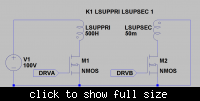stube40
Member level 3
- Joined
- Feb 10, 2010
- Messages
- 55
- Helped
- 4
- Reputation
- 8
- Reaction score
- 4
- Trophy points
- 1,288
- Location
- Queensland, Australia
- Activity points
- 1,825
We've been looking for a low-voltage high-current power supply for our lab to put between 200A and 1000A through a superconducting coil with inductance of 50mH. Total resistance of the load will be around 0.1 Ohm.
The only thing I've been able to find so far is an electro-plating rectifier. Although it's called a rectifier, as far as I can see it's actually a low-voltage high-current PSU.
The manual (attached) is not very informative. It is a 3-phase input. Switchable DC output from 0-15V and 0-1000Amps. It is based on IGBTs. Power factor of 0.95, 2% ripple. It has either constant current or constant voltage operation.
It's very expensive ($12500!!!) and I'm worried about buying it and then it not doing what we require (or, even worse, we break it because we're mis-using it).
Can anyone shed any light on whether we're going doing the wrong track or not?
The only thing I've been able to find so far is an electro-plating rectifier. Although it's called a rectifier, as far as I can see it's actually a low-voltage high-current PSU.
The manual (attached) is not very informative. It is a 3-phase input. Switchable DC output from 0-15V and 0-1000Amps. It is based on IGBTs. Power factor of 0.95, 2% ripple. It has either constant current or constant voltage operation.
It's very expensive ($12500!!!) and I'm worried about buying it and then it not doing what we require (or, even worse, we break it because we're mis-using it).
Can anyone shed any light on whether we're going doing the wrong track or not?
